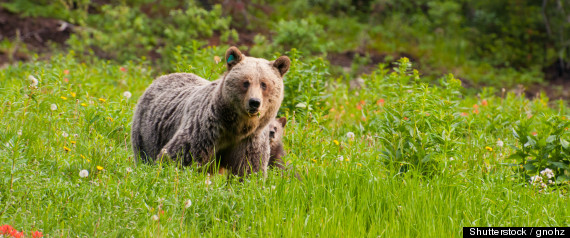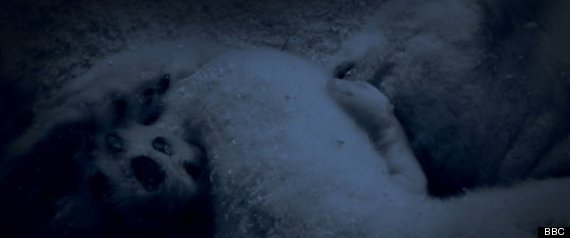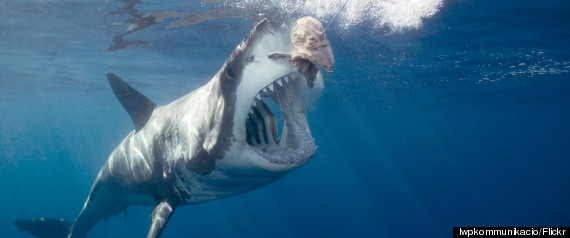
Filming animals takes a long, boring time. Can we blame the filmmakers for taking a few shortcuts here and there? Maybe, if animals are being mistreated or misrepresented along the way.
Of course, most nature documentarians have nothing but the best intentions. The Huffington Post spoke with Chris Palmer, longtime filmmaker and author of two books on fakery in wildlife programs, about the filming tricks most audiences don't know about.
"They may go out with determination to get the actual footage," Palmer said. "But after a couple of days when you've got nothing, when you've got 24 hours left and the money's running out, you get kind of desperate. Because you've got to put food on the table; you've got to look after your family, send kids to college. It's a real ethical dilemma."
Many networks aren't helping, either, by giving filmmakers just days to capture the kind of high-octane footage that will keep audiences entertained. And field producers are feeling the pressure, according to a 2009 study on ethics in wildlife documentaries by the Center for Media and Social Impact.
Perhaps most surprisingly, filmmakers aren't generally asked to explain how they got their shots. "A lot of bad things happen that we don't even know about," Palmer explained. The rest of us find out about what goes on in the field mainly through anecdotal evidence spread by filmmakers' word of mouth. With that in mind, here are the surprising tricks some have used to get their perfect shots:
Producers have staged predator-prey interactions by putting M&Ms in found carcasses for trained animals to sniff out, among other artificial methods. Some might even cause animals harm.

A (presumably) wild bear.
Captive bears are often trained using small candies, Palmer explained. To get a shot of a bear sniffing what looks like a fresh kill, filmmakers might place some jellybeans or M&Ms in a roadkill carcass to spark the bears' interest. Often this is acknowledged in a credit at the end of the production. But how many viewers pay attention to end credits? Failing to show obvious disclaimers, Palmer argues, can harm the trust between audiences and documentarians.
Wild creatures are also baited with false prey by (again, generally well-meaning) producers. In his 2015 book Confessions of a Wildlife Filmmaker, Palmer wrote about his colleague Tom Campbell who'd once attracted sharks to his boat by towing a fake seal behind it. The sharks leapt out of the water trying to capture the "seal," and Campbell got some amazing shots. Later, however, he learned that the sharks' energy for such stunts is limited -- given enough attempts, they'll stop trying to hunt a meal and go without.
But there are ethically creative ways to get a good shot out in the field. Filmmakers Carol and Richard Foster once baited vampire bats with -- brace yourself -- a live human being, Palmer told HuffPost. Their volunteer got a rabies shot and pretended to sleep so the bats would dig in for a snack, and the Fosters would get their footage.
Sometimes, close-up shots actually show zoo animals, or rented animals in a pen.

A still from BBC's "Frozen Planet."
Sometimes the terrifying predators shown onscreen have, in fact, been rented from game farms for easier filming. Doug Allan, a documentarian known for his skillful shots of arctic animals, disclosed some wildlife documentary trickery in his 2012 book Freeze Frame. Many times, Allan explained, small animals are filmed on enclosed "habitats" -- including nearly every shot in the BBC's "Hidden Kingdoms" documentary. "There's massive skill in set filming," Allan told the Guardian, "but it's not the one that I have."
Set filming isn't limited to small animals, however. A scandal erupted in 2011 when it was revealed that the BBC's "Frozen Planet" docuseries (which, coincidentally, Allan worked on) had included footage of a captive polar bear cub at a Holland zoo. The network actually pulled the same stunt in a 1997 documentary with bears at a Belgian zoo. A subsequent investigation by the Sunday Telegraph revealed that creatures shown in BBC documentaries are "routinely" filmed in captivity -- such as clown fish hatching not in the open water but at a university research center, or a supposedly wild pheasant filmed in a nature park -- giving audiences little notice.
After three decades of wildlife filmmaking, Palmer admitted using some filming tricks in his own work, too. In his 2010 tell-all book Shooting In the Wild, he explained how the crew behind the 1999 documentary short "Wolves" actually filmed canines they'd rented from a game farm, Animals of Montana, Inc. An up-close shot of a mother wolf feeding her pups was shot on a controlled set. Celebrated wildlife advocate David Attenborough has spoken out in support of shooting captive animals in the name of human and animal safety. Presumably, that's only if the creatures have been kept humanely.
Certain programs use computer-generated imagery without giving audiences fair notice.

A loggerhead turtle off the coast of Florida.
Hugely popular shows like "Planet Earth," made without CGI, might be an argument against artificial imagery. Advances in computer imaging, however, have made it possible to fool even seasoned experts like David Attenborough. Watching the Hollywood adaption of "Life of Pi," Attenborough remembered jumping back when he saw actors so close to a tiger he didn't realize was computer-generated.
CGI does allow filmmakers to illustrate documentaries without disturbing the creatures we want to learn about and conserve. The problem is a lack of notice given to viewers. The 2009 documentary "Turtle: The Incredible Journey," for example, includes extensive computer-generated effects to show loggerhead turtles making their impressive trek from waters off Florida to the coast of Africa. Without a disclaimer, "How can viewers trust that the whole thing hasn’t been made up?" wrote Manohla Dargis for The New York Times.
Stories of animal families are cobbled together with footage from a bunch of different animals.
CGI can help some filmmakers craft a coherent narrative about, say, one loggerhead turtle making a long voyage. Another trick, though, is just to film several lookalikes and edit the film together.
Palmer explained in Shooting In the Wild how his team used this tactic when making the 1996 documentary "Whales." Without the time or money to follow a pod of humpback whales 3,000 miles from Hawaii to Alaska, they created a story of a mother-calf duo with footage of several different individuals.
Some producers set up hunt scenes where prey had little to no chance of survival.
In 1996, the Denver Post reported that "Wild America" host Marty Stouffer had not only staged many of the series' most dramatic scenes, but he did so at the cost of some animals' lives. Allegedly, Stouffer allowed a deer and a pack of wolves to be placed together in an enclosure, among other staged predator-prey interactions.
"Film costs $125 a roll," Stouffer explained. "We don't have eight or 10 or 100 hours of film to leave rolling until one of these fish grabs a bug." After an internal investigation, PBS dropped the series.
Decades earlier, Palmer explained, animal abuse was more or less routine. For example, a big cat chasing a rabbit might have the upper hand because producers had tied a clear string around the rabbit's leg, slowing it down. One producer admitted to letting an animal wrangler break a rabbit's leg so the team could get a better shot of a predator in action, according to the 2009 CMSI study. In 1966, Life magazine published a photo series showing a (captive) leopard fatally attacking a baboon. The leopard had been released onto a group of baboons -- instead of scrambling for the trees like all the others, one baboon turned to face the leopard, and was killed.
Others edit footage to make animals appear more dangerous.

A great white shark on the hunt.
It's no secret that more dramatic wildlife footage gets higher ratings. Animals hunting, charging and attacking are the shots producers crave -- so much that they sometimes fabricate the drama. "Wild America," for example, allegedly portrayed a playful scene between a tame cougar and its handler as a ferocious attack. Producers on series like "Yukon Men," "Shark Week," "Swamp People," and others can easily remix footage and add foreboding music to craft entertaining -- yet only partially accurate -- shows, Adam Welz argues for the Guardian.
Even traditional nature documentaries have to grapple with misrepresentation. Sharks, for example, are commonly baited with "chum," a delightful mixture of fish guts and blood. But the resulting frenzied activity presents an unnatural picture of sharks' feeding habits, and one that makes them seem more like killing machines.
Sensationalized footage can "distract from the real issues" of animal conservation, Palmer explained. But warmer ocean temperatures are far less captivating than sharks leaping from the water.
Sounds of birds flapping their wings or bears splashing in a river might have been recreated in a studio. Artificial sounds are probably the most common form of deception in documentaries. Some wouldn't even consider it "faking." It's difficult (not to mention dangerous) to get camera equipment close enough to capture the sound of, say, a polar bear skidding on ice. So, back in the studio, a sound editor might record someone squeezing dry custard through a pair of women's leggings to recreate it. Or opening and closing an umbrella to mimic the sound of birds' wings. Or, as happened in an early documentary of Palmer's, splashing around in a bucket of water to imitate a bear in a river.
Adding sounds, however, seems forgivable. Splashing water is better than silence, even if it was made by some guy in a studio.
And of course, there was that time Disney producers killed a bunch of lemmings to "prove" they committed mass suicide.

From Disney's 1958 "White Wilderness."
Yes, that happened. Producers of Disney's 1958 "White Wilderness" documentary decided, for some reason, that they needed to "prove" a lemming-related urban legend: The animals routinely commit mass suicide when their numbers increase too much. So they purchased lemmings from some Canadian kids for 25 cents apiece, shipped them to the filming location and forced them to leap into the water, with camera angles artfully concealing the filmmakers' interference. Audiences were made blissfully unaware of the producers ethical failings, and the finished product won an Oscar. A 1982 investigation by the Canadian Broadcasting Corporation proved the dramatic scene was, indeed, all fake.
Or that other time when Disney producers pushed a polar bear down some rocks.
Yep, that happened, too. Again in "White Wilderness," producers thought they'd give audiences a laugh by filming a polar bear tumbling down a steep snow-covered hillside, apparently due to lack of foresight on the animal's part. But the whole scene -- rocks and all -- had been rigged.
Filmmakers probably aren't pulling any such stunts these days, Palmer noted. Pushing a bear down a cliff in 2015 would be a quick career-ending move if the public found out. And the BBC, for its part, has begun providing ethics training for its wildlife producers. But still, good films take time and money to make -- two things many networks can't or won't always provide. While much responsibility rests on the filmmakers out in the field, networks should be doing their part to make sure footage is captured in an ethical, animal-friendly way, Palmer said. Change depends on commitment from both networks and producers to give an honest representation of wildlife.